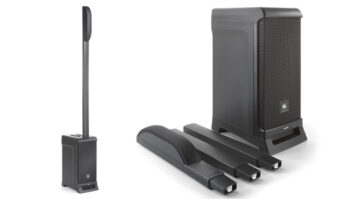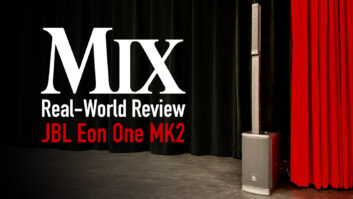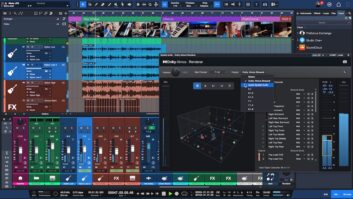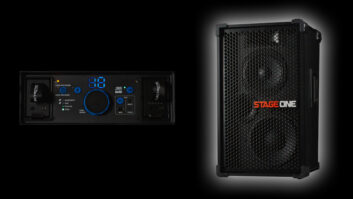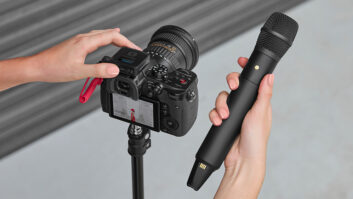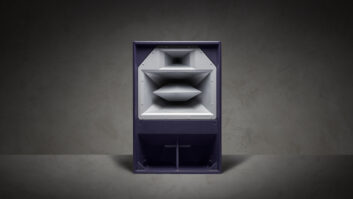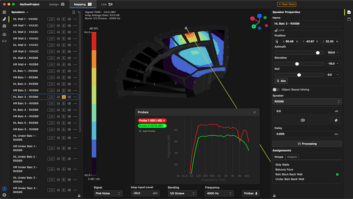
The Complete Mark Pinske Interview
by Chris Michie
DAY ONE
Pinske: Where I’m from originally? Where I was born? I was bornin Arlington, Minnesota.
Mix: Are the Pinskes a family from there?
Pinske: It’s a German name. I was born and raised in Minnesota,basically. Moved to Florida to go to college. And from Florida went outto California, which is where I started the trek on everything,there.
Mix: How did you get into audio? Were you doing audio incollege?
Pinske: Actually, yeah. I kind of did it on the side as I was incollege. I actually played in some groups, some music bands, andstarted doing sound and live sound. I kind of got to be the guy inGainesville, Florida. When I got there, I kind of got to be the guythat made the demo tapes for people. I started getting interested init, and I had a little 2-channel Revox recorder, and mics and stuff. Imade lots of demos for little bands around town, plus went out and didsound. Kind of took it on as a hobby at that point, while I was incollege.
Mix: What were you doing in college?
Pinske: I started studying for architectural acoustics, and thenI went into electrical engineering. I got a degree in electricalengineering. A BSEE degree. I came out of college, took one of thefirst jobs I could, designing power lines and stuff. Went out on theroad with some of the P.A. companies, Clair Brothers and Showco. Iworked for Maryland Sound. Did a lot of touring.
Mix: What year is this?
Pinske: That would have been ’76, around 1974-76.
Mix: So this is a time when those companies you just namedwere pretty established. The whole touring industry was-
Pinske: Oh yeah. I did a lot of different things. I did B.B.King, I did sound for Weather Report. I did some of the Broadway showplays that would come through. I did some of those-“Jesus Christ,Superstar” for a short spell.
Mix: Mixing front of house?
Pinske: This is all front of house. Just front-of-housemixing.
Mix: Not many people had monitor mixers then.
Pinske: I did Melissa Manchester. Had a lot of live experience.I decided that there was not a lot of credits there, and if I wanted toget a little bit better known, I needed to do recording. I went out toLos Angeles. I actually took a job for a manufacturer out there, justto get me out there, which was Quad Eight Electronics, and I wasworking there as an engineer. Designing film consoles. That’s when Imanaged to get an audition set up to audition for Frank Zappa.
Mix: I know quite a bit about the musician’s auditions,because there’s a bunch of stuff on the Internet about interviews withthem, but I never heard that he also auditioned engineers.
Pinske: Absolutely. It was a little tough, because originally,he’d just built the studio.
Mix: And this was a high-end home studio?
Pinske: It was a $3.5 million studio he built at his house up onWoodrow Wilson Drive, up in the Hollywood Hills. Very elaborate studio.It was designed by Rudy Brewer, originally. It had a huge 48-tracksetup of a Harrison console. And when I auditioned, he was justfinishing up the studio. A guy named David Gray, who works with Dolbynow, was there, pretty much putting in some of these elaborate systems.I remember when I did the audition, what he did was he auditioned eachengineer for about one day in the studio, and then you’d go down to asound stage, and he would see how you would do live, and had you putsome stuff on tape. So one of the first things that happened to me withFrank-it was a similar thing. I got there, he asked me to put hisguitar through a whole bunch of stuff. There was a new console withoutpatchbay that wasn’t even labeled, and I was patching around, and hesaid something to me like-this is one of the things I’ll neverforget-he said, “I’m not a robot, you know. I can only stay interestedin these things for mere moments.” And I was just taking a little tonegenerator and patch it around to see what would light up. Later on, itwas kind of interesting. I thought, “Oh, man. I’ll never get this job.This guy’s too quick.” So I did some stuff for him, mixed it ontape.
The next day, went down to a sound stage where he had everything setup. He was getting ready to do a tour. They had all brand-new Midasconsoles, the kind with–the brand-new line of Midas that was outthere. He had a guy kind of mess them all up. Said, “OK, make it soundgood.” And he walked around with his wireless guitar. Then he had meput the stuff on a cassette, while we were doing it. And he said he wasgoing to take that tape and the tape in the studio and he’d get back tome in about two weeks. Well, two weeks went by, and I didn’t hearanything, so I figured, oh well, I didn’t get that gig. And all of asudden I’m in my office at Quad 8 and the phone. Honest to God truth,this is so funny. The phone rings and he says, “You ready to go?” Hedidn’t say who he was, he just said, “Are you ready to go?” And I justsaid, for lack of thinking what else to say, I just said, “Well, thecar’s running.” “The motor’s running.” I said something like that. AndI had been at this place for almost three years. Actually, it was alittle over three years I was there. So I just pretty much accepted thegig. I cut a deal with him that I would fly with the band. Because Itold him I had done too much road traveling, and I really didn’t wantto be on the bus smelling dirty socks again. And I really wanted toconcentrate on doing a better job, and he said, “OK,” so we went alongwith that setup.
So I started off with him. We went out, got ready for that tour. Wedid live tours. This would be-that was the fall of ’79, so 1980 and thebeginning of ’81, we did some live tours before we built the recordingtruck. So I did all front of house then. Then we did a couple ofremotes as we were on tour.
Mix: Were you recording to 4-track or something, while youwere doing front of house?
Pinske: We did some recording to 8-track. We rented a recordingtruck a couple of nights. We kept an 8-track and a 4-track, and we hada little Soundcraft 1-inch 8-track that we were running some tapes. Butwe didn’t tape all the time. We just taped some shows. I mainly didhouse mix, and then when we got back in the studio, after the tour, westarted working on studio albums, and then putting together tapes fromsome live tapes that he had previous to before when I was there. WhenKerry McNab, Joe Chicarelli, Davey Moire, some of the guys that werethere just before me. They had a collection of all kinds of tapes.
And Frank pretty much wanted to spend all his time, and now that hehad his own studio, he pretty much wanted to work around the clock.That’s when we got the idea that when we were going to go out on the’81 tours-we’d just finished up-we’d put together “Tinsel TownRebellion” album. That’s the first full live collaboration I did withhim. You’ll see a lot of engineers credited on there. My name’s thefirst name, and then there’s a bunch of other ones of people who did alot of the tapes-the collections of tapes-and it was a double album.And then we did the studio album, “You Are What You Is,” which ispretty much an all-in-the-studio album. Which is pretty much all mybaby. I even did some vocals on that one. That was pretty funny.
But when we finished that up, we started moving into, “well, whatcan we do to have a better situation live?” That’s when I decided thatwe could build a recording truck. And that’s where the Utility MuffinResearch Kitchen recording truck was pretty much born. I bought-theshell of the truck I bought from the Beach Boys. They had this sittingup in the backyard of their house. They hadn’t been using it so much.So I took the shell of the truck-it was a 27-foot trailer. We prettymuch had to redo everything in it. Added a new hydraulic airbag,shocks, and all that kind of stuff. It was a little bit beaten up. Butthe inside of it was still pretty good shape. We took a Neve-had a Neve8108 on the front of it. We wired it up for an elaborate amount ofinputs, because I didn’t want to have to be somewhat in a tour, havesome bad channels, and stop and do repairs, and stuff like that. So wekind of did an overkill on all that.
Mix: You wired it up for extra channels?
Pinske: Right. I had 142-channel ins. Three 24-track machines,and four videos.
Mix: Video recorders?
Pinske: Right. And we had a Neve 8108 across the front. Then wehad a custom made Midas made for us by Midas, that went down along thewall, which is pretty much normal the first hundred channels. Now wealso did an endorsement with Carvin, which adds a couple extra boards,but normally we would use like 96 channels live. We would puteverything on its own channel. All the channels that were over the 96that we used were pretty much all spare channels. So we did a littleendorsement, we took a little picture of the truck and put a couplelittle Carvin boards up on the wall for anything that was over Channel100. And Frank stood there and took a little picture and they recycledthat thing, and we were able to get some free equipment out of it andall that kind of stuff.
Mix: It doesn’t sound as though you used it as primarymixers.
Pinske: No, no. They were just there for-what happened was, wetook that picture, and we got extra keyboards and amplifiers. Thekeyboard players on stage would use some of the Carvin mixers for theirkeyboard rigs on stage left and stage right. We had Tommy Mars at thattime.
Mix: Peter Wolf?
Pinske: This was just after Peter Wolf. I came in right at theend of Peter Wolf. Before we did the recording-truck stuff, it was allTommy Mars and Bobby Martin. Bob Harris. Ed Mann came back around.
Mix: For that “Tinsel Town Rebellion,” Steve Vai was theguitar player, right?
Pinske: Steve didn’t really come in ’til a little later.
Mix: I don’t know my history as well as I should.
Pinske: That was mainly a collection of a lot of live stuff.Steve came in a little later. Steve was a whole interesting story allof his own, to tell you the truth. We auditioned him. He was a kid thatwas going to Berkeley that charted out some of the music for Frank. Andhe had a number of different people all over the country that he wouldtake our cassettes and send them to, and they would chart out thesheets and send us back to them. And Steve was one of those kids thatdid an immaculate job on charting out the sheets. And one day Franksaid, “I’m flying him out here.” And I’m thinking, “What the heck’s heflying out another guitar player for?” So that’s how Steve’s auditionhappened. He was like 19, 18 years old then. Just turning 19. Thatwhole band, when we got Chad Wackerman, after Vinnie Colaiuta had left,we auditioned like, gee whiz, I think it was somewhere like about 31drummers or something. A huge amount of drummers. We had trouble tryingto replace Vinnie, because Vinnie was really good. We ended up withChad Wackerman, who was 21 years old. Then we had Steve Vai, who camein at 20. And we had Scott Thunes on bass who was 21 years old. Theywere all young guys that had come in, that had pretty much won theauditions. So that’s when we had the younger set coming in.
Mix: Between Vinnie and Chad, there’s a drummer called DavidLogeman.
Pinske: David Logeman played on the “You Are What You Is” album.He was pretty much a studio drummer, but we did do a live tour. We dida short American tour that David Logeman was on as well. He wasn’t withus overseas, I don’t think. Maybe he was, for one of our short overseasstints. But David Logeman was with us for a pretty good while inbetween there, too.
Mix: You were talking about getting the truck together andgoing-you actually had three 24-track recorders runningsimultaneously?
Pinske: We overlapped the tapes. Originally we started offanalog 2-inch tape, at 30 ips. We ran two Ampex MM1200s. And I had a 3MM79 machine in the back. The one in the back was primarily a spare. Sowhat we did is, we took the 24 buses that we ran, and we overlapped thetapes by about a minute or two minutes, so that we could always editthem all together later. I tried to make as many big reels as I could,14-inch reels. Normally, we just took out of the box, reels, ran them,started this next machine one minute before the other one would runout, and we just kept altering the machines as the night went on. Andthat way everything got caught on tape.
Mix: So 30 ips?
Pinske: 30 ips, yep.
Mix: Non-Dolby?
Pinske: Non-Dolby.
Mix: How many reels would you go through? How long were theshows, at this point? Did he play with an opening act?
Pinske: On the first three-months tour, we had 946 master tapes,if I remember correctly. I can almost remember the number. A hugeamount of master reels of tape. Matter of fact, we did use Dolby onsome channels, but most of the time we didn’t use Dolby. He hated Dolbyon the cymbals and stuff. I’m trying to remember how many reels we hadon an average-normally it would take about eight reels a show,overlapping them. Somewhere along that, depending how long the set was.A lot of times we did these small theaters in America. We did like theFox theaters, the Palladiums, those kind of places, so we would dodouble shows. And that way we would record two whole shows, and Frankhad a habit of not repeating any of the songs from the second show tothe first show, so we’d have pretty much different tunes through bothshows.
Mix: What date are we at, with the beginning of the truck,when you got it from the Beach Boys?
Pinske: I built the truck in the spring of 1981. That’s when thevery first tour it went on, I guess would be in– the first tour we didin 1981, and then we recorded-it pretty much went on every tour afterthat. We took it overseas. We put it on the Queen Mary, and we shippedit across to-we rehearsed originally over in Denmark, or Amsterdam. Wetook it all around Europe. We recorded all of Europe on the truck aswell.
Mix: Presumably there was a driver. If you’re traveling withthe band, and also presumably at some point you stopped doing front ofhouse and you started working the truck.
Pinske: Yeah. At that point, in 1981, is when we went throughabout two or three different house mixers. Bob Stone came on board alittle later. He did some house mixes. We had a couple of guys-one guy,Chris that was with us for a while. Mike Abbott. We called him Rat Man.We had a variety of different house mixers. We had Marque Coy doing themonitors. It was a real elaborate set up. What we did was, I used to dosome of the submixing from the truck. We had that, like I said,142-channel snake, but 30 of them were like direct lines. So I couldtake an individual input, for instance, on all the drums. I could have22 channels on the drums. We’d have Syndrums or Simmons drums, or acombination of a whole set. We’d have a lot of individual direct micsinside. I would take the combination of all of it, and send, forinstance, tom-toms left and right back out to the house. The housewould have it’s own kick, it’s own snare, it’s left and right toms,left and right overhead cymbals and the separate hi-hat, whatever. AndI would take things like that on the keyboards, as well. We might takenine different stereo keyboards, and I would mix them all down to astereo keyboard mix. And the stereo keyboard mix could go back to themonitors onstage, and back to the house mix. What we found by doingthat is we had a lot more control over the feedback, and we had a lotless problems with the recordings because we had the same sonic tone,and the same path pretty much going to each of the locations.
Mix: Then the truck was an integral part of the whole P.A.setup.
Pinske: Absolutely. That’s one of the reasons we used it all thetime. Because I had 85 noise gates in the truck, and we could prettymuch really, really control everything. And I could solo stuff up upthere. It was really brilliant because we could solo stuff up and Icould hear problems, like little buzzes or hums or something like that.We could isolate the problems, and I could treat them with some of thebest outboard gear you could get, and send it back to these guys and itwould be all spiced up. And of course, you’re not going to get the kindof equalization that you have in a Neve console out of a littleportable Midas board.
Mix: So you were contracting with different P.A. companies inAmerica and Europe.
Pinske: With me personally, or with the Zappa tour?
Mix: With Zappa.
Pinske: With Zappa we owned our own P.A. We bought the JohnMeyer system.
Mix: Which one? A JM-3 system, or an earlier . . .
Pinske: Yeah. We had the very first M-3 system that he made.
Mix: The MSL-3s?
Pinske: Yeah. We took it all over the whole-we bought thatsystem from John. In fact, that was the first one he made, and I evenhelped John out with a couple of problems. He had a couple ofmicroprocessor problems in the first ML-3. The microprocessors had alittle bit of a problem, and we ended up having a little problem moreon a couple of the horn things. But after that-that was just a PC boardproblem. Once that got fixed, we never had any problems with the stuff.It was fabulous. We had A and B amplifiers, a full spread of his stuff.Took it all around the world.
Mix: At this point, you would have been just stacking at theside of the stage, rather than flying it?
Pinske: We flew it. We flew it as much as possible. But inAmerica, most of the time, as you know, there may have been only roomto fly a center cluster or something. And some of these small theaters,we’d stack it, right. We had to stack it on the side of the stage. Butwhen we went over to Europe, it was all bigger places. And when we’dplay something like Madison Square Garden, for instance, in New York,then we would hire Audio Analysts to come in as a back up system. Andwe would tie in with them. We’d do our time alignment, and use them forsupport, so that we could carry those huge, huge venues.
Mix: It sounds to me as though, by the time you joined theZappa organization, pretty much all the equipment was owned or boughtfor the tour.
Pinske: Oh yeah. That’s the way he did things. We owned allthe sound and all the stage. What we would do with the lights, though,we would buy a system from LSD Lighting, we would use it for threemonths and then sell it back to them. And he would hire three guys onthe crew for the lights. He did that instead of renting the lights. Andhe had a-Frank was a pretty smart businessman. By the time we wouldfinish a tour, we would actually save a lot of money by buying thesystem and just paying for the crew to run it, than we did-especiallyon lights, because light rentals were so expensive. So he would dothings like that all the time.
Mix: And obviously you owned the recording truck. Did you buybuses as well? I’m just curious about the evolution of the touringbusiness, as he did it.
Pinske: As far as the methods he used?
Mix: . . . Never mind. . . . The first thing you did was mixesfor “Tinsel Town Rebellion.” And then a studio album, “You Are What YouIs.” And then you were out on tour for the rest of ’81 with this newtruck.
Pinske: No, we didn’t go on tour the rest of ’81. We didrecording in the studio in between, as well. Every time we cameback-like we did an American tour for three months, then we went in thestudio, then we went in Europe. Then we came back and went in thestudio. Every time we were off the road, we were back in the studio. Sowe were putting together a whole bunch of different albums. We did the”Ship Arriving Too Late to Save the Drowning Witch,” which was thewhole “Valley Girl” thing. We did the “Them or Us” album. We did “ManFrom Utopia.” We just kept putting albums together, one right after theother. A whole slew of them. Then we did a bunch of guitar albums,based off the live stuff that we found. “Shut Up ‘n Play Your Guitar”instrumental stuff. We just kept, all the time, trying to get as muchproduct as we possibly could. The cool thing about doing the truck was,we came back and we had all these tapes that we could listen to, andthen we could sort out good performances live, and edit togethersections of a song. That’s when we started putting together the MammyNun escapade, which was a six-sided-was originally going to be asix-sided album Broadway-play-type thing.
Mix: Oh, the “Thing-Fish?”
Pinske: The “Thing-Fish,” right. “Thing-Fish” was the actualtitle of it. It was a six-sided album. That was basically done off ofall live recordings I had made in the truck. But then we overdubbedsome different lyrics and different vocals and stuff in the studio. Sothat was kind of interesting, because we had enough isolation. As amatter of fact, the whole thing starts out, the whole “Thing-Fish”album starts out with the song “The Mammy Nuns,” and it’s a guitar thatFrank had during a soundcheck in the Sportehalle in Vienna. Which isthis huge place that if you drop a chair, it would last for eightseconds. He did a little guitar segment during rehearsal. And Frankused to love the sound of the room when it was empty, when there wereno people in it. And I had PCM microphones up on the stage, facing outtoward where the audience would be, so you would hear the whole room.And he started a little guitar thing and put it in a loop, and set itdown, and it was just looping. The whole start of that album isbasically that live track of him just playing it during the soundcheck, which is how the album started out. We started doing things likethat. We started recording things during sound checks just for the,”OK, let’s put this down on tape and then later on maybe we’ll use iton something.” That got to be a lot of fun, because that’s when westarted experimenting with taking live stuff, segueing it into whateverwe did in the studio, spicing stuff in the studio, and back and forth.And doing edits and cuts to other live shows.
Mix: I’m not sure where I read it, but I think one interviewI read, I guess with a musician, said that some of the basic trackswhich appear on the album as maybe four songs in a row where theysegue, or they seem like they’re hard edits, in fact they were recordedas tracks the way you hear them.
Pinske: As a matter of fact, he segued almost everything live.He would always segue the songs, and he would give it a little-you knowhow Frank directed on stage. He had these little signs that he woulddo. He would pull his hair and they would go into a reggae temp, or hithis forehead and they’d go into a New Wave or a punk tempo. And hewould always direct a downbeat on the end of a song which would goright into the next song. So a lot of those segues were actually justthe way they were performed. A lot of times we would use those seguesas a place to edit. We would come from the Hammersmith Odeon in Londonto maybe Frankfort, and come back to the Santa Monica Civic Auditorium.And the same song might travel through a number of different shows.Which was unbelievable, because that meant that the tempos had to beright, everybody had to be in tune. He was really hard on everybodywhen it came to that. The musicians were nothing but top notch when itcame to that stuff.
Mix: This must have taken a lot of work every day, in termsof sound check and setup. Was there a schedule, or did it depend on thetraveling?
Pinske: Every day, I had a guy, Tom Ehle, who works with Dolbynow also, who aligned all the machines in the truck for me. I wouldcome in with the band, we would do a sound check. Sometimes we wouldlay some stuff down on tape. Normally do a sound check to make sure thehouse and the monitoring system and everything was all in sync. A lotof times the recording truck wasn’t too far off, because the Neve andeverything had pretty much detented settings. Because we had the samemicrophone built inside the drums. We worked with John Goode, who isthe vice president of DW Drums, him and I developed a system with RandyMay, May Systems now is a pretty well-known drum-type mic setup. Wedeveloped a system. John and I worked with Chad Wackerman, and alsowith Sugarfoot, with the “Thriller” tour, developing this thing. Weused mics that were built inside the drums. We tuned the drums exactlythe same every day. John would put new heads on, between the soundcheckand the show. We used little Teflon nuts that would not slip, to makesure that everything stayed in tune as well as possible. We did anelaborate setup with the drums, but normally the mics and the directpickups and everything on the stage were identical. So we didn’t haveto change a whole lot in the truck, because the Neve had detentedsettings. So everything was repeatable. It really didn’t change toomuch from day to day as far as what we had. It was a matter offine-tuning it, and bringing the room into control. We might voice theroom a little bit differently because of the acoustics of it, or thesize of it. We’d make sure that the monitors were not conflicting withwhat was going on with the truck.
The stereo side mixes for Frank-he would have sidefills as well ashis footfills. And the sidefills-I did a mix from the truck that wentto his sidefills. So he could hear the whole band a little bit comingthrough the sidefills, which were some more Meyer MSL-3s. There was twoof them on each side on stands, facing him in the middle, and I woulddo a little stereo mix that went to him there. And then Marque Coy, whowas the monitor mixer, would have the overall volume control over it.That way he could get kind of an idea of what the whole band wassounding like in a little bit more of a high-fidelity situation thanwhat was going on in the truck. It just gave him a better feel.
Mix: He had a quite elaborate guitar-I know it was at leaststereo. Did he have more than two cabinets?
Pinske: Absolutely. We tracked five channels of guitar on everyshow. He had a rack, a double rack, which he called “the blue box forbimbos,” which is pretty well known over the years. It had everythingfrom the cheap Electro-Harmonix Big Muff on up into it. Almost any kindof guitar gimmick you could ever imagine. He had what was called a”dirty” setup and “clean” setup. And both the dirty and the cleans werein stereo. So if he hit on a switch and went to his Marshalls, or inthis case with the Carvin versions of the Marshalls, that drove hisMarshall cabinets, he’d play his powerful distorted setup. Do whatevereffects he’d have on in the rack. And then there was another switchthat hit him through a clean setup, which went through Crown DC300power amps, into a real clean, elaborate speaker system. It even had an18-inch speaker. It was just real powerful and real clean sounding. Sowhat I did, was I would stereo mic both sets, the clean amplifier instereo, the dirty amplifier in stereo, and they would take up fourtracks on the multitrack. The fifth track was used for a direct out. Hehad a wireless coming from his guitar, and we went through a Vegawireless system, and I took the wireless direct and went right directlyonto tape. This way, if the amplifiers screwed up during the show, wecould take the direct channel, put it through amplifiers in the studio,which we did a lot anyway. We would take the direct signal, put itthrough amps in the studio, and maybe mess with it while we weremixing. Because he usually didn’t like playing again in the studio. Wewould take a live solo, and then we might enhance the recording withputting a couple Marshalls in the reverb chamber or something likethat, miking them up. And we could use that direct signal to just kindof recreate what we did on the live stage.
Mix: But presumably on the live albums, including all theguitar albums, the guitar tone you hear is what he was getting on stageat the time.
Pinske: Absolutely. With a few exceptions. Like when we did”Coneheads,” for instance. The “Saturday Night Live” thing. I got himto do a real elaborate solo on that thing in the studio, which was justan all-studio solo overdub. But most of the time Frank used to like touse the live-whatever live show he felt was the best solo.
Mix: I’ve read quite a lot about it, but actually this is oneof the few albums I don’t yet have. Apparently all the guitar solos on”Joe’s Garage” were actually live solos flown in over tracks.
Pinske: Absolutely. They were live solos. A lot of them wereflown in over tracks. Some of them were taken from different shows.
Mix: But that was the album that came out before you startedworking with Frank.
Pinske: The end of “Joe’s Garage,” I was actually still workingon. But Joe Chicarelli was the engineer. In fact, Joe Chicarelli hadquit at that point, or gotten fired or something. So I kind of had tofinish that up. That album wasn’t really one of my albums. I’m notcredited on it, but I did some work on the end of it. That was kind ofmy apprenticeship, so to speak. The real first album I did was the”Tinsel Town Rebellion” album, as far as having credits on it and doingall the work myself. That’s where we started on it. We’ve continued todo those same tactics. For instance, we would do something like “What’sNew in Baltimore” from Hamburg, and then we would cut away to the2-inch tape from the Hammersmith Odeon because Frank loved the way theguitar sounded in that theater. And then we would edit that solo in,and then come back after the solo and go to some other city. Maybe toBaltimore, or the Tower Theater in Philadelphia, or something likethat. We would edit around all the time between live things. We wouldlisten to solos, probably until we were totally sick of it. There’s notmany master tapes.
Mix: I was going to say, you presumably logged the tapesduring each show, but did you make comments? Did Frank keep a log ofwhat were good shows? Or did he just keep it all in his head, or didyou listen to it all back again later?
Pinske: We both had our ideas which shows were the best. When wecame back off the road, we did all kinds of exercises. Because Frankwould sometimes get mad at the band when they’d make mistakes. So he’dcome back and he’d write a little list and say, “Gee, I can’t wait tolisten to this show or that show.” So we might listen to Paris, or wemight listen to his favorite show. He would say, “What shows do youthink were good?” We’d listen to some of my shows, the ones I had goodrecording nights on. And then we’d try to evaluate the performance ofthe bands. But Frank was always one of these kind of guys that wouldalways try something-if something wasn’t working, he’d say, “Well,let’s try something stupid.” He said, “What were the worst nights weco
